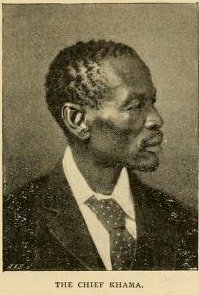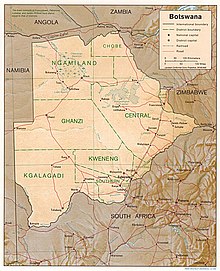History of Botswana
The history of Botswana ranges from early Stone Age settlement over a million years ago to the immigration of the Bantu and the British protectorate of Bechuanaland (German also Bechuanaland ) to the state of Botswana , which has been independent since 1966 .
prehistory
An early Stone Age settlement can be proven in the greater Kalahari region a good million years ago . Settlement can also be proven for the Mesolithic and the Neolithic . Early settlers were the San and their related Khoikhoi . Her testimonies include rock art in the Tsodilo Hills , including the earliest known work of art known to man. Around 3000 BC A great migration of Bantu peoples from West Africa began. The cause of the emigration is seen today in climatic changes, which triggered a gradual transformation of the Sahara region into a desert. Around the year 190 the Bantu crossed the Zambezi and reached the area of what is now Botswana; they introduced iron working in this room.
Pre-colonial history
Around the year 650 the state of Toutswe emerged in the area of what is now Botswana , which reached its heyday around 1050 and existed until around the 15th century. Economically, this state was based on a considerable wealth of livestock as well as its supra-regional trade relations. The rulers gave the cattle to poorer residents who were used for services and tributes. The empire got its current name due to archaeological finds on Toutswemogala Hill north of Palapye .
Around 1300 the kingdom of Toutswe lost its supremacy to the kingdom of Mapungubwe , but remained in place. Possibly under the pressure of the rising power of the neighboring empire of Greater Zimbabwe , the state fell apart in the 15th century. As early as 1095, western Sotho reached what is now southern Botswana and founded the Kgalagadi empires. With the demise of Toutswe, more Basotho and Batswana invaded . Various small empires were formed, and by 1800 the entire eastern part of what is now Botswana was settled by Batswana.
In the course of the Mfecane , Bakololo and Ndebele - under General Mzilikazi - moved west around 1830 , which also resulted in military clashes with the Batswana.
Colonial history
From the 1830s, large parts of the Boer population moved north from the Cape Colony , attacking Batswana as well; they levied taxes and took slaves . Colonization began around 1840 by the first white missionaries and traders who advanced into what is now Botswana. In 1845 Sir David Livingstone founded Botswana's first permanent mission station for the London Missionary Society in Kolobeng .
From 1852 to 1853 Boers, among them the young Paul Kruger , attacked the Batswana and robbed women, children and cattle. Mission stations were also attacked and destroyed, but the planned permanent occupation failed. For their part, the Batswana invaded the Boer territories to the east until the leader of the newly formed South African Republic , Andries Pretorius , concluded a peace treaty with the Batswana. In 1867 Karl Mauch discovered large gold deposits on the Tati near what is now Francistown .
There was another war between Boers and Batswana from 1881 to 1884 when the Batswana in the south of the area were attacked by Boer and British mercenaries. As a result, the Boer republics Stellaland and Goshen were founded on the land of the Batswana , partly after negotiations with Koranna who were also resident there . The two areas were occupied by British troops under pressure from British magnate Cecil Rhodes and in 1885 they were declared a crown colony of British Bechuanaland . Today the area belongs to South Africa .
At the same time, at the request of the Batswana, the area of what is now Botswana was declared a British protectorate of Bechuanaland . After the Second Boer War at the beginning of the 20th century, the British began to introduce a tax system, the Hut Tax (roughly: " Hut Tax "), which was collected from the local rulers. Their internal leadership role initially remained unaffected.
The British South Africa Company (BSAC) founded by Cecil Rhodes , a monopoly company endowed with sovereign rights, later offered to further develop and manage Bechuanaland - in return for the granting of appropriate concessions to exploit the land. This and the associated annexation of Bechuanaland was made by the Batswana heads ( BaKgosi ) Khama III. , Bathoen I. and Sebele I. , who traveled to London in 1895, insisted on adherence to the protection treaties and thus prevailed - also because shortly afterwards the Jameson Raid failed. A certain integration into the South African administration can be observed throughout. So the area was administered from the South African Mafeking . From 1896 to 1897 a railway line from Mafeking through the east of Bechuanaland to Southern Rhodesia was built, which the BSAC needed to transport goods from Northern and Southern Rhodesia bypassing the South African Republic (see also: Rail transport in Botswana ). In 1910, Bechuanaland formed the customs union of Southern Africa with other areas in the region . The BaKgosi took over a large part of the administration until the 1950s.
Around 1920 the European Advisory Council and the Natives Advisory Council were set up, which were able to make recommendations for the respective population group.
The British government did little to develop the Protectorate. Botswana was one of the poorest countries in Africa when it gained independence. At that time it only had five kilometers of paved roads and three secondary schools .
In 1950, the two councils were merged to form the Joint Advisory Council (roughly: "Joint Council"), thus taking the first steps towards independence for the country. A constitution passed by this body in 1960 created the Legislative Council (LEGCO), a parliament that initially also had an advisory role. The Europeans made up the majority there. Several parties emerged from 1959, including the Bechuanaland People's Party , which advocated immediate independence, and in 1961 the more moderate Bechuanaland Democratic Party (BDP). In June 1964, the British decided to grant the country independence. A second constitution, based on the British Westminster system , was passed in 1965. In addition to the National Assembly , the House of Chiefs was established - a predominantly ceremonial chamber with no veto for BaKgosi and other traditional rulers. At the same time, the capital was moved from Mafikeng to Gaborone , so that the area had its own administrative headquarters for the first time. This year, for the first time, elections were held in which the BDP, under the leadership of Seretse Khama , was able to achieve more than 80% of the votes. Khama was the nominal head of the Bamangwato and grandson of Khamas III. However, because of his marriage to the British Ruth Williams Khama, he had to waive his claims for a time.
Independence and Post-Colonial History
Botswana gained independence on September 30, 1966, and joined the British Commonwealth at the same time . Seretse Khama, who had already become Prime Minister in 1965, became Botswana's first President. He succeeded in largely keeping the country out of conflicts with its neighbors.
The country's economic situation improved dramatically shortly after independence, after the first large diamond deposits were discovered near Orapa in 1967 . To this day, Botswana derives a large part of its income from diamond exports. The high income led to rapid development in the country: in 2003 there were already around 6000 kilometers of paved roads and around 300 secondary schools.
Khama appointed the South African professor and former ANC official Zachariah Keodirelang Matthews to the Botswana diplomatic service in 1966. He represented the interests of the country until his death in 1968 both in the United States and before the United Nations .
In 1974 Botswana joined forces with Angola , Mozambique and Tanzania to form the group of “ front-line states ” that supported the liberation movements in Namibia and what was then Rhodesia . In 1979, these front-line states, together with Lesotho , Malawi , Zambia and Swaziland, founded the Southern African Development Conference (SADCC), initially as a counterweight to South Africa. In 1977 the Botswana Defense Force was established to protect the borders with Rhodesia and later with South Africa and South West Africa . On several occasions, Botswana fell victim to South African military operations, which were primarily aimed at activists from the African National Congress , which is banned in South Africa . However, after the end of the apartheid regime in 1992, South Africa also joined the SADCC, which has since operated under the name of the Southern African Development Community ( SADC ) and has its headquarters in Gaborone.
After Seretse Khama's death in 1980, Ketumile Masire became president, followed by Festus Mogae in 1998 . Festus Mogae was re-elected on November 30, 2004. As of April 2008, Ian Khama , a son of Seretse Khamas, was the President of Botswana. In 2018 he was replaced by Mokgweetsi Masisi . All presidents belonged or belong to the Botswana Democratic Party (BDP), which has also won all previous parliamentary elections with an absolute majority .
Botswana has been a UNESCO member since 1980 .
See also
literature
- Fred Morton, Jeff Ramsay, Part Themba Mgadla: Historical Dictionary of Botswana. Scarecrow Press, Lanham, Maryland / Oxford 2008, ISBN 978-0-8108-6404-7 . Excerpts from books.google.de
- Fred Morton, Jeff Ramsay: A history of the Bechuanaland Protectorate from 1910 to 1966. Longman, London 1990, ISBN 0-582-00584-1 .
- Thomas Tlou, Alec Campbell: History of Botswana. 2nd Edition. Macmillan, Gaborone 1997, ISBN 0-333-36531-3 .
Web links
- History of Botswana at thuto.org (English)
Individual evidence
- ↑ a b c d e f g h History of Botswana from 1,000,000 BC Chr. To 1700 ( Memento of 4 July 2015, Internet Archive ) on the website of the Electoral Institute for Sustainable Democracy in Africa (English)
- ↑ Fred Morton, Jeff Ramsay, Part Themba Mgadla: Historical Dictionary of Botswana. Scarecrow Press, Lanham, Maryland / Oxford 2008, ISBN 978-0-8108-6404-7 , p. 38. Excerpts from books.google.de
- ↑ Description of Toutswemogala Hill at asapa.org.za (English), accessed on June 14, 2015
- ↑ Overview at sahistory.org.za (English), accessed on June 14, 2015
- ↑ Fred Morton, Jeff Ramsay, Part Themba Mgadla: Historical Dictionary of Botswana. Scarecrow Press, Lanham, Maryland / Oxford 2008, ISBN 978-0-8108-6404-7 , p. 45. Excerpts from books.google.de
- ↑ Fred Morton, Jeff Ramsay, Part Themba Mgadla: Historical Dictionary of Botswana. Scarecrow Press, Lanham, Maryland / Oxford 2008, ISBN 978-0-8108-6404-7 , p. 46. Excerpts from books.google.de
- ↑ Newspaper article in The Chronicle from 1895 at trove.nla.gov.au (English), accessed on June 14, 2015
- ↑ Fred Morton, Jeff Ramsay, Part Themba Mgadla: Historical Dictionary of Botswana. Scarecrow Press, Lanham, Maryland / Oxford 2008, ISBN 978-0-8108-6404-7 , p. 169. Excerpts from books.google.de
- ^ A b Jenny Clover: Botswana: Future Prospects and the Need for Broad-based Development. Institute for Security Studies, 2003 ( Memento from March 7, 2016 in the Internet Archive ) (English; PDF; 74 kB)
- ↑ Botswana: political party formation and independence (1958–1966). Extracted from: "Botswana" IN Compendium of Elections in Southern Africa (2002), edited by Tom Lodge, Denis Kadima and David Pottie, EISA, 37-39. EISA 2002, accessed April 29, 2018 .
- ↑ Member countries at unesco.de , accessed on June 14, 2015




